HAMPTON, Va. — NASA is set to test new technology developed at Langley Research Center in Hampton that aims to make a key aspect of space travel easier.
On November 1, the space agency plans to launch an "inflatable heat shield," which is designed to help spacecraft slow down much quicker when returning from space. If successful, the shield would allow spacecraft to transport heavier payloads through the atmospheric entry process.
During the test flight, the shield will enter the Earth's orbit and inflate to nearly 20 feet (six meters) in diameter in what NASA describes as "the largest blunt body aeroshell to ever go through atmospheric entry."
David Young, the deputy center director of Langley Research Center, said the shield was developed with an eye on interplanetary space travel.
"This is an innovative technology that's really advancing our ability to land larger masses on another planet -- say, when we go to Mars -- or to bring more mass back to the Earth," Young said.
So, how will this work? When a spacecraft enters an atmosphere, aerodynamic drag slows it down, converting its kinetic energy into heat.
A larger inflatable shield would create more drag faster and at a higher altitude than a traditional shield, which is typically constrained to the size of the fairing (the top of a rocket that contains the payload).
"You're coming in from space at hypersonic speed, so for instance, you'll be coming in at 20 times the speed of sound, so you've got to find ways to slow yourself down to a slower speed, so then you can deploy things like parachutes or retro propulsion so you can land safely," Young explained.


Young said the shield would be necessary for a human mission to Mars, which has an atmosphere much thinner than Earth's, thus less aerodynamic drag.
In addition to people themselves, a mission to Mars would also carry the cargo and protective equipment needed to keep them alive, which Young described as "much more massive" than anything that has landed on the Red Planet before.
The shield would also enable spacecraft to land on Mars at higher elevations.
"If you're looking at science, we've been very limited as to where we can actually land on Mars, because with smaller heat shields, you need more atmosphere to slow you down," Young explained. "So, you can only land in the lowlands, but there's very interesting scientific geological features in the highlands and we'd be able to do that now."
The technology would also benefit missions to the Moon, allowing astronauts to transport lunar samples. It could also be used to transport secondary stages of rockets back to Earth, making the cost of space travel cheaper.
How the test flight will work
The shield will launch as a payload aboard a ULA Atlas V rocket from Vandenberg Space Force Base in California, sharing a ride with a NOAA satellite.
About 20 minutes after launch, the NOAA satellite will be released and the second rocket stage containing the payload will orbit the Earth once. Upon the completion of the orbit, the shield will begin its descent back to Earth, inflating over an hour after launch.
Young said the shield is expected to land somewhere in the Pacific Ocean, close to Hawaii, about 50 to 60 minutes later.
If the test is a success, Young said NASA is looking to create a heat shield larger than six meters, something that will require additional demonstrations of the technology to assure confidence for use in future missions.


